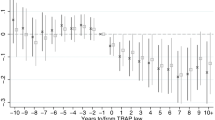Abstract
Restrictive state abortion laws make it more difficult and costly for women to obtain an abortion. The fundamental law of demand posits that an increase in the cost of an abortion should cause the number of abortions to decrease. This suggests that restrictive state abortion laws should cause women with unintended pregnancies to have fewer abortions and concomitantly more unintended births. This paper investigates the impact four restrictive state abortion laws—No Medicaid Funding, Parental Involvement, Mandatory Counseling and Waiting Periods—have on the unintended birth rates of the 50 US states for the year 2006. Using a variety of methodologies, the empirical results show that, contrary to the theoretical prediction, these four antiabortion laws do not have a significant positive effect on unintended birth rates.
Similar content being viewed by others
References
Cockrill, K., & Weitz, T. A. (2010). Abortion patients’ perceptions of abortion regulation. Women’s Health Issues, 20, 12–19.
Cohen, J. E., & Barrilleaux, C. (1993). Public opinion, interest groups and public policy making in the American states. In M. L. Goggin (Ed.), Understanding the new politics of abortion (pp. 203–221). Newbury Park, California: Sage Publications.
Finer, L. B., & Kost, K. (2011). Unintended pregnancy rates at the state level. Perspectives on Sexual and Reproductive Health, 43, 78–87.
Finer, L. B., & Zolna, M. R. (2011). Unintended pregnancy in the United States: Incidence and disparities, 2006. Contraception, 84, 478–485.
Folbre, N. (2001). The invisible heart: Economics and family values. New York: New York University.
Goggin, M. L., & Wlezien, C. (1993). Abortion opinion and policy in the American states. In M. L. Goggin (Ed.), Understanding the new politics of abortion (pp. 190–202). Newbury Park, California: Sage Publications.
Guttmacher Institute. (2008, 2006, 2004, 2002). State policies in brief. New York: Guttmacher Institute.
Haas-Wilson, D. (1997). Women’s reproductive choices: The impact of medicaid funding restrictions. Family Planning Perspectives, 29, 228–233.
Joyce, T. (2011). The supply-side economics of abortion. New England Journal of Medicine, 365, 1466–1469.
Kane, T. J., & Staiger, D. (1996). Teen motherhood and abortion access. Quarterly Journal of Economics, 111, 467–506.
Levine, P. B. (2003). Parental involvement laws and fertility behavior. Journal of Health Economics, 22, 861–878.
Levine, P. B., Trainor, A. B., & Zimmerman, D. J. (1996). The effect of medicaid abortion funding on abortions, pregnancies and births. Journal of Health Economics, 15, 555–578.
Matthews, S., Ribar, D., & Wilhelm, M. (1997). The effects of economic conditions and access to reproductive health services on state abortion rates and birthrates. Family Planning Perspectives, 29, 52–60.
Medoff, M. H. (2002). The determinants and impact of state abortion restrictions. American Journal of Economics and Sociology, 61, 481–494.
Medoff, M. H. (2007). Price, restrictions and abortion demand. Journal of Family and Economic Issues, 28, 583–599.
Medoff, M. H., & Dennis, C. (2011). Public preferences, political party control and restrictive state abortion laws. American Review of Politics, 30, 307–331.
Medoff, M. H., Dennis, C., & Stephens, K. (2011). The impact of party control on the diffusion of parental involvement laws in the US states. State Politics and Policy Quarterly, 11, 325–347.
Norrander, B., & Wilcox, C. (1999). Public opinion and policymaking in the states: The case of post-Roe abortion policy. Policy Studies Journal, 27, 702–722.
Sen, B. (2003). An indirect test for whether restricting medicaid funding for abortion increases pregnancy-avoidance behavior. Economics Letters, 81, 155–163.
Sonfield, A., Kost, K., Gold, R. B., & Finer, L. B. (2011). The public costs of births resulting from unintended pregnancies: National and state-level estimates. Perspectives on Sexual and Reproductive Health, 43, 84–102.
Author information
Authors and Affiliations
Corresponding author
Rights and permissions
About this article
Cite this article
Medoff, M.H. State Abortion Policy and Unintended Birth Rates in the United States. Soc Indic Res 129, 589–600 (2016). https://doi.org/10.1007/s11205-015-1135-y
Accepted:
Published:
Issue Date:
DOI: https://doi.org/10.1007/s11205-015-1135-y



